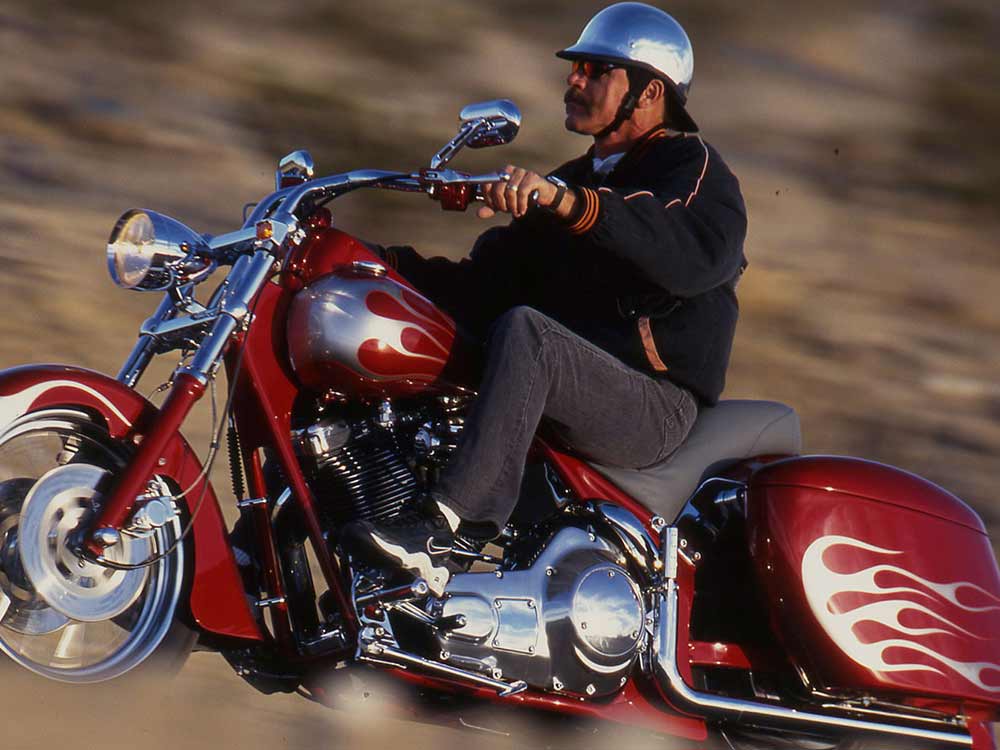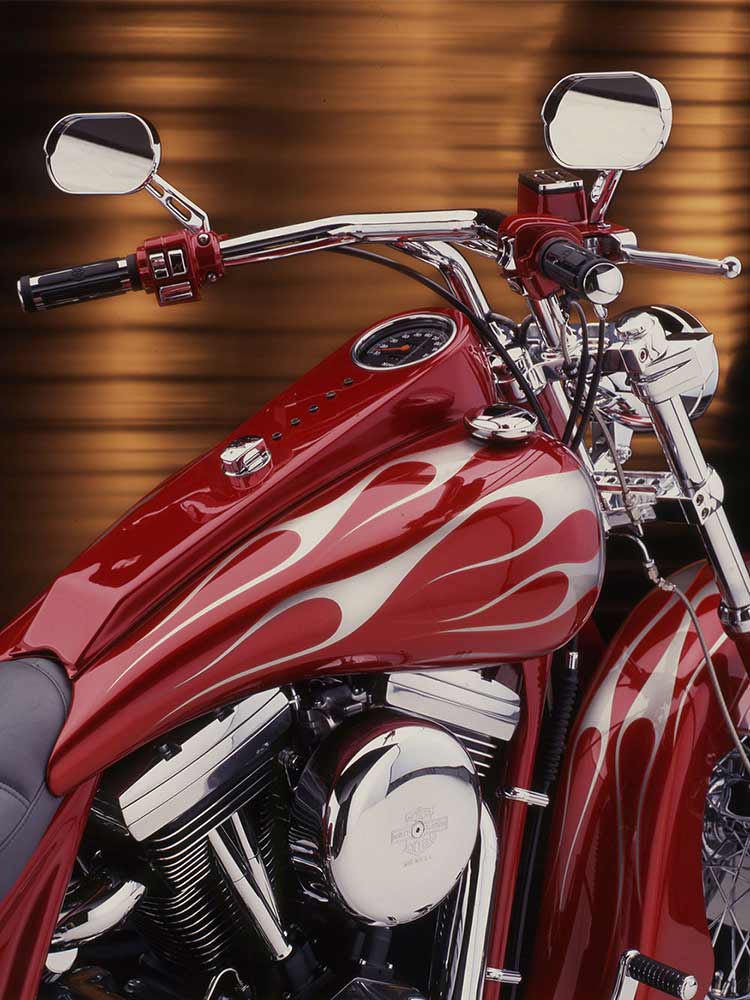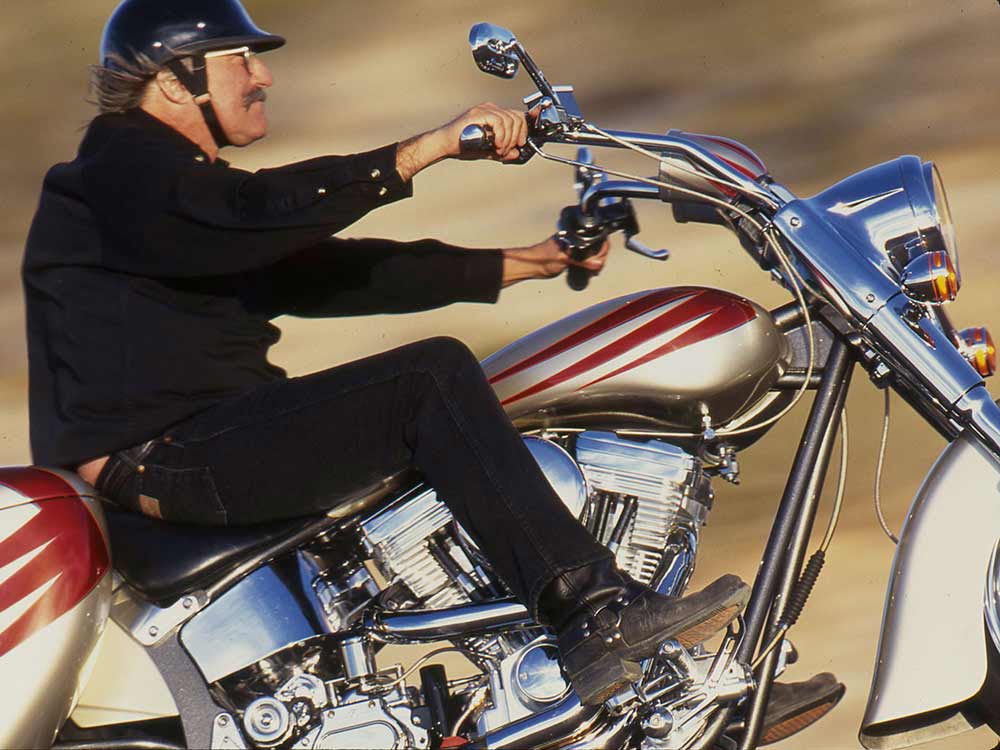A Pair of Virtually Identical, Yet Completely Different Custom Harley-Davidsons

Two custom Harley-Davidsons that are virtually identical, yet are completely different.
Brian Blades
This article was originally published in the Feb.-March 2000 issue of Cycle World’s Big Twin magazine.
They are two handsome ships of the desert. They were created in the same town, finished in the same shop by many of the same people and have the same, custom-with-bags-attached style. Even their owners share the very same philosophy about motorcycles: Let’s ride! If, along the way, anyone cares to gawk at the machinery, fine; but sailing along deserted highways is the point of it all. And the more often, the better.
Given all those similarities, how different could these two baggers possibly be?
As different as night and day.
Well … make that as different as Elliott and Day. The candy-red bagger with silver flames is a stock-framed, nearly stock-engined piece that belongs to a fellow named Rick Elliott; the silver bagger with candy-red feathers has a big-inch motor in a custom frame and is owned by Phil Day.
If Day’s name has a familiar ring, it’s probably because he is the owner and founder of Daytec, highly acclaimed builders of custom frames for Harley-Davidsons. Seven years ago, when Day started bending tubes and fabricating frames for Big Twins, his company offered just three different models. Today, Daytec employs 90 people and ships thousands of frames each month, and the selection of models has virtually exploded up to a whopping 125.

“I made a frame jig. Then I cut the neck off the bike, relocated the head 2.5 inches away, and made metal go out to meet it.”
Brian Blades
All of which Day has ridden, if not on his annual pilgrimage to and from Sturgis, then along Highway 138 in California’s high-desert country near his headquarters in Hesperia. Ownership of the business gives Day the freedom to ride any time he chooses, a privilege he frequently exercises as chief test rider; he just has to stay until midnight some nights to catch up on paperwork.
Day’s bagger started with—what else?—a Daytec frame. It’s a model called the Episode, and it cradles Delkron cases that can handle the output from a 97-inch motor built with Patrick Racing Billet Cylinders and Heads breathing through a 42mm Mikuni carb and a Hooker exhaust. “Mating different heads and headers creates a different exhaust note,” says Day.” I’ve bolted Hooker headers onto a set of Edelbrock heads and didn’t like the sound; it was like a tractor. I ended up putting a Thunder Header on that bike. But bolt the Hookers up to a set of Patrick heads and they give the exhaust note I’m looking for. So, that’s what I did with this bike.

For the most part, Elliot took a more conservative approach when building his bagger: stock frame, slightly modified; stock motor, slightly modified. The bodywork, though, is considerably modified.
Brian Blades
Day was just as fussy about his choice of tires. The rear is an original-equipment hoop from a Honda Valkyrie, while the front is standard fare on a lot of Japanese sportbikes. “I like to run radial tires front and rear,” he says, “but I probably fitted 10 different sets before I found a combination that impressed me. Some combos didn’t work at all.”
Just as camels store water, desert dwellers store metal. If you’ve ever traveled through the desert, you’ve no doubt seen the piles of steel, aluminum and rust everywhere. Day is no exception, still hoarding parts from his marine engineering days of many years ago. Which explains his bagger’s unique speedo and tach mounts. “I hate to tell you what I made those things out of,” he says. “That was a hurry-up job, just a few days before Sturgis last year. I started with a couple of old marine engine exhaust-pipe bends and … well, you know the rest.”
For Day’s preferred method of open-road cruising, strong torque, easy ridability and good fuel mileage rate far above traffic-light-beating acceleration. That’s why he mated a RevTech six-speed gearbox to his big-inch motor. “The six-speed drops the rpm out on the road and makes the ride more comfortable, more relaxed. It lets the engine run right where it should be at 80 mph. It’s so comfortable, I love it.”
Apparently, Day doesn’t love the silver bagger enough to give it a sexy name, though. With all the romance of a camel drover, it’s simply called Daytec Number Two.
So, where does Elliott fit into this picture? Just about everywhere, it turns out. Not only is he one of Phil Day’s best friends and riding buddies, both of his sons work for Daytec.

“Bolt the Hookers up to a set of Patrick heads and they give the exhaust note I’m looking for.”
Brian Blades
For obvious reasons, then, Elliott should be riding a Daytec-framed bike. Actually, he does have an unfinished one he’s been working on for two years. “Phil keeps telling me, ‘Why don’t you finish building the bike you have in your garage?’” recalls Elliott, who insists that he will, in time. But for now, the foundation for his bagger is an ex-California Highway Patrol FXRSP, 1988 vintage. It was well street-worn, showing 45,000 miles on the odometer, before he ever took a torch to it.
The project turned out to be much more involved than Elliott ever imagined. “After riding to Sturgis on an FXR with leather bags alongside all these other guys on customs, I felt like an outcast. I thought it’d be easy just to throw on a set of Daytec fiberglass bags and be one of the boys.”
Eight months and about 17,000 shekels later, the bike was complete.

Day’s bagger has unique tach and speedo mounts that were apparently made just a few days before Sturgis.
Brian Blades
Earlier in his life, Elliott made a living as a welder, and he had to rely upon some long-unused fabricating techniques when modifying the FXRSP’s rear tubes and stretching the frame. As he explains it, “I made a frame jig. Then I cut the neck off the bike, relocated the head 21/2 inches away and made metal go out to meet it. Then I boxed it back in and stretched the tubes, too. It’s all metal now. It doesn’t look that heavy, but believe me, it is.”
With his penchant for spending long hours on the road, Elliott really liked the vibration-smoothing rubber engine mounts of the FXR; so, that part of the frame did not change. And for the sake of on-the-road reliability, neither did he make any serious modifications to the engine; a cam, a carb, forged pistons and a set of pipes pretty much sum up the full extent of Elliott’s hot-rodding.
He did, however, get rather creative with the bagger’s bodywork. He stretched the tank and channeled it to fit the dash, which he fabricated from nine separate pieces of metal. He also built an oil tank that fits under the transmission, to open up some space. The oil filter and cooler live under the tranny, too, permitting the battery to be relocated down below the frame rails. This allowed the seat to have more padding for those 4000-mile weeks on the road.
And speaking of the seat, it was built by George’s Upholstery in Hesperia specifically for long rides across the desert. Says Day, “Most of the seats today are narrow, slim and hard—exactly what you don’t need for 600-mile days. But when some people see the seat on Rick’s bagger, they say that it’s too big for the bike. When you’re sitting on it, though, you’re so comfortable that you’re happy to sacrifice style for comfort.”

As you might expect from a bike built by a frame manufacturer, Phil Day’s bagger is based on one of his own Daytec frames. It carries a 97-inch motor driving through a six-speed gearbox that permits high-speed touring at low rpm.
Brian Blades
And the bags? Well, just as Elliott intended from the very outset of his project, they’re Daytec units. But he couldn’t keep his hands off of those, either. They’ve been widened and lowered, and Elliott removed the shock pockets and installed taillights from a 1998 Freightliner truck (he’s in the trucking business these days). Another nice detail is the inner fender that covers the rear tire to protect the delicate electrical components, and the stunning paint, from road debris.
Like most custom projects, this one went right down to the wire. The bike wasn’t finished until the very evening before Elliott was scheduled to head for Laughlin in 1999. He acknowledges that he couldn’t possibly have made that deadline without all the help he got from the guys at Daytec.
But some things are better done alone. Like riding. Being out on the open road, heading for the horizon and beyond, 200 miles between stops for drinks and fuel, is heaven for these two baggers and the guys who own them. Because in the desert, it seems like you could ride forever.
| Specifications | Phil Day’s Custom Bagger: | Rick Elliot’s Custom Bagger |
|---|---|---|
| Bike Name: | Daytec Number Two | FXR Bagger |
| Base Machine: | 1997 Daytec Special Construction | 1997 FXRSP |
| Owner: | Phil Day, Hesperia, CA | Rick Elliott, Apple Valley, CA |
| Designer/Fabricator/Builder: | Phil Day/Daytec 17469 Lemon St. Hesperia, CA 92345 760/244-1591 | Rick Elliott 14381 Cronese Rd. Apple Valley, CA 92307 760/946-3025 |
| Paint and Chrome: | ||
| Molding: | Daytec | Tim James |
| Painter: | Daytec | Tod “Troll” Marino |
| Graphic Artist: | Daytec | Tod “Troll” Marino |
| Chroming: | Orange County Plating | High Desert |
| Polishing: | Daytec | High Desert |
| Engine | ||
| Year: | 1997 | 1988 |
| Model: | Custom Construction | FXRSP |
| Builder: | Daytec | Phil Arlotti |
| Displacement: | 97 cu. in. | 80 cu. in. |
| Cases: | Delkron | H-D |
| Lower end: | S&S | H-D |
| Rods: | S&S | H-D |
| Pistons: | JE | Wiseco |
| Heads: | Patrick Racing | H-D |
| Cylinders: | Patrick Racing | |
| Valves: | Patrick Racing | H-D |
| Cam: | Patrick Racing #1 | Crane Fireball |
| Pushrods: | Crane | Crane |
| Lifters: | Jims | Crane |
| Primary cover: | H-D | H-D |
| Ignition | Crane Hi-4 | Dyna S |
| Coils/wires: | Crane | Dyna S |
| Carb: | Mikuni | Mikuni |
| Air cleaner: | Rivera | CCI |
| Pipes: | Hooker | BUB Custom |
| Mufflers: | Hooker | n/a |
| Make: | RevTech | H-D |
| Type: | 6-speed | 5-speed |
| Primary drive: | H-D | H-D |
| Clutch: | Primo Pro Clutch | Barnett |
| Frame | ||
| Make: | Daytec | H-D |
| Type: | Episode | FXRSP |
| Builder: | Daytec | Rick Elliott |
| Modifications: | 320 rake, 5” stretch | Extensive small modifications, 2.5” stretch |
| Front Fork | ||
| Make: | H-D | H-D |
| Year: | 1992 | 1988 |
| Rear Suspension | ||
| Make: | Progressive | Progressive |
| Swingarm: | Daytec Episode Touring | H-D |
| Front Wheel/Tire | ||
| Wheel: | RevTech | H-D |
| Tire: | Dunlop D204 | Dunlop |
| Tire size: | 130/80-16 | 100/90-19 |
| Rim width: | 3” | 3.5” |
| Brake: | RevTech | CCI |
| Rear Wheel/Tire | ||
| Wheel: | RevTech | H-D |
| Tire: | Dunlop D206 | Dunlop |
| Tire size: | 180/60-16 | 130/90-16 |
| Rim width: | 51/2” | 4” |
| Brake: | RevTech | H-D |
| Accessories | ||
| Handlebar: | Daytec | Ness |
| Risers: | n/a | n/a |
| Grips: | H-D | H-D |
| Mirrors: | n/a | KüryAkyn |
| Gas tank: | Daytec 5-gallon, 5” stretch | H-D |
| Oil tank: | Daytec | Rick Elliott |
| Front fender: | Daytec | Daytec |
| Rear fender: | Daytec | Daytec |
| Headlight: | H-D | Headwinds |
| Taillight: | Hi-Tech Products | Ness |
| Turnsignals: | H-D | CCI |
| Electrics: | Daytec | Rick Elliott |
| Speedo: | VDO | H-D |
| Tach: | H-D | |
| Instruments: | Daytec custom mounting | |
| Seat: | Daytec | George’s Upholstery |
| Foot controls: | Performance Machine | Ness |
| Saddlebags: | Daytec | Daytec, modified by Rick Elliott |






